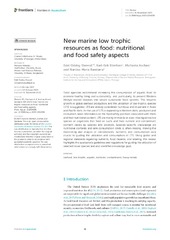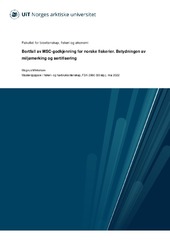Norges fiskerihøgskole: Nye registreringer
Viser treff 241-260 av 1758
-
New marine low trophic resources as food: nutritional and food safety aspects
(Journal article; Tidsskriftartikkel; Peer reviewed, 2023-11-01)Food agencies recommend increasing the consumption of aquatic food to promote healthy living and sustainability, and, particularly, to prevent Western lifestyle-related diseases and secure sustainable food systems. This requires growth in global seafood production, and the utilization of low trophic species (LTS) is suggested. LTS are already considered nutritious and important in Asian and ... -
Understanding the effect of design parameters on the filtration efficiency of trawls intended for commercial harvesting of zooplankton
(Journal article; Tidsskriftartikkel; Peer reviewed, 2023-11-01)A major challenge for the aquaculture sector is access to sustainable and cost-effective raw materials for feed. Copepods (Calanus spp.) have potential to meet this need for large volumes of marine raw materials to enable sustainable growth of aquaculture production worldwide. However, the lack of an energy- and catch-efficient trawl technology has limited the development of this fishery in the ... -
Enzymatic Hydrolysis of Orange-Footed Sea Cucumber (Cucumaria frondosa)—Effect of Different Enzymes on Protein Yield and Bioactivity
(Journal article; Tidsskriftartikkel; Peer reviewed, 2023-10-07)While sea cucumber is a food delicacy in Asia, these food resources are less exploited in Europe. The aim of this study was to determine the chemical composition and potential food applications of the less exploited orange-footed sea cucumber (Cucumaria frondosa). In particular, the antioxidative capacity and free amino acids associated with the umami flavor released by enzymatic hydrolyses by ... -
Are offshore platforms a good candidate to restore functional diversity of reef fish communities in the Arabian Gulf?
(Journal article; Tidsskriftartikkel; Peer reviewed, 2023-09-04)Human-made structures are ubiquitous in the marine realm. Complex structures such as oil and gas platforms may constitute a suitable habitat for species in areas where natural reefs have been highly degraded by coastal development. We here explore the suitability of fish assemblages associated to offshore platforms as surrogates for depleted fish stocks from coastal areas. Taxonomic and functional ... -
Associations between serum taurine concentrations in mothers and neonates and the children's anthropometrics and early neurodevelopment: Results from the Seychelles Child Development Study, Nutrition Cohort 2
(Journal article; Tidsskriftartikkel; Peer reviewed, 2023-08-25)Background: High concentrations of taurine are present in the developing human brain and maternal breast milk. Taurine is thought to influence fetal growth and brain development based on experimental rodent studies. As fish is an important dietary source of taurine, we investigated associations between taurine concentrations and child outcomes in a high fish consuming population.<p> <p>Objective: ... -
Over 20% of marine fishes shifting in the North and Barents Seas, but not in the Norwegian Sea
(Journal article; Tidsskriftartikkel; Peer reviewed, 2023-08-31)Climate warming generally induces poleward range expansions and equatorward range contractions of species’ environmental niches on a global scale. Here, we examined the direction and magnitude of species biomass centroid geographic shifts in relation to temperature and depth for 83 fish species in 9,522 standardised research trawls from the North Sea (1998–2020) to the Norwegian (2000–2020) and ... -
Fra havets bunn til sykehuset
(Chronicle; Kronikk, 2023-08-19)I forskningsgruppa Marbio ved UiT Norges arktiske universitet jobber vi med å finne nye legemidler fra forbindelser som vi henter fra ulike planter, dyr og mikroorganismer. -
Uncovering neutral and adaptive genomic differentiation among European perch with brackish water and freshwater origin in the western Baltic Sea region
(Journal article; Tidsskriftartikkel; Peer reviewed, 2023-09-13)Environmental variation across the range of wild species can lead to local adaptations. The Baltic Sea was formed when the Fenno-Scandian ice sheet retreated around 12 thousand years ago, creating a new brackish water habitat colonised by both marine and freshwater fish species. The European perch (Perca fluviatilis) is a predatory freshwater fish with a large geographical distribution across ... -
Reducing plastic pollution caused by demersal fisheries
(Journal article; Tidsskriftartikkel; Peer reviewed, 2023-10-07)Marine microplastics generated by wear and tear of bottom trawls and demersal seines during their service life is a growing environmental concern that requires immediate attention. In Norway, these fishing gears account for more than 70 % of the landings of demersal fish species, but they are also the leading sources of microplastics generated by fisheries. Because these two fishing gears are widely ... -
Phylogeography and molecular diversity of two highly abundant Themisto amphipod species in a rapidly changing Arctic Ocean
(Journal article; Tidsskriftartikkel; Peer reviewed, 2023-07-30)Rapid warming in the Arctic is drastically impacting marine ecosystems, affecting species communities and food-web structure. Pelagic Themisto amphipods are a major component of the Arctic zooplankton community and represent a key link between secondary producers and marine vertebrates at higher trophic levels. Two co-existing species dominate in the region: the larger Themisto libellula, considered ... -
Effects of Codend Mesh-Shape and Size on the Size Selectivity of Demersal Trawl Targeting Banded Scad (Alepes djedaba) in the Beibu Gulf, South China Sea
(Journal article; Tidsskriftartikkel; Peer reviewed, 2023-07-09)In order to optimize the size selectivity of demersal trawl targeting Banded Scad, Alepes djedaba, in the South China Sea (SCS), we tested and compared the selective properties of four experimental codends. These codends included two diamond-mesh codends (T0 codends) with different mesh openings (30 and 35 mm), and two T90 codends (the netting was turned by 90 degrees) with the relatively same ... -
Bioaktive forbindelser i brunalger
(Master thesis; Mastergradsoppgave, 2020-05-15)<p>Hensikten med marin bioprospektering er å identifisere interessante bioaktive forbindelser som kan ha potensial for kommersiell utnyttelse og videreutvikles til blant annet legemidler. De fleste av disse bioaktive forbindelsene har man til nå funnet i organismer som lever på land, men når man nå leter etter nye stoffer er det enorme biologiske mangfoldet i havet en veldig interessant plass å ... -
"Når det blåser i fra ØST" - Om bruken av økosystemtjeneste-perspektivet i kystsoneplanleggingen
(Research report; Forskningsrapport, 2019)Denne rapporten er et resultat av prosjektet Coreplan, som har undersøkt om metoder og tilnærminger som finnes i litteraturen om økosystemtjenester kan bidra til å styrke kystsoneforvaltningen. I rapporten diskuterer vi utviklingstrekk i norsk kystsoneplanlegging og hvordan utviklingen i bruken av kysten kan stille nye krav til kystsoneplanleggingen. Vi forklarer bakgrunnen for begrepet økosystemtjenester, ... -
Fish investigations in the Barents Sea winter 2017
(Research report; Forskningsrapport, 2017)Annual catch quotas and other regulations of the Barents Sea fisheries are set through negotiations between Norway and Russia. Assessment of the state of the stocks and quota advices are given by the International Council for the Exploration of the Sea (ICES). Their work is based on survey results and international landings statistics. The results from the demersal fish winter surveys in the ... -
Studier av B-celler hos laks (Salmo salar) - Aktiveres de av TLR-ligander?
(Master thesis; Mastergradsoppgave, 2022-05-29)Virussykdommer hos atlantisk laks (Salmo salar) er en av de største utfordringene i norsk akvakulturindustri, og i tillegg til store økonomiske tap for næringa, fører virussykdommene også med seg store fiskevelferdsmessige problemer. Virusvaksinene som er tilgjengelig på det norske markedet i dag har vist å gi begrenset grad av beskyttelse, og velferdsmessige bekymringer er knyttet opp mot bivirkningene ... -
Studiar av B-celler hos laks (Salmo salar) – blir dei aktiverte av TLR-ligandar?
(Master thesis; Mastergradsoppgave, 2022-05-29)Pankreassjukdom, infeksiøs lakseanemi, hjarte- og skjelettmuskelbetennelse og kardiomyopatisyndrom er dei mest utbreidde virussjukdommane i oppdrettsnæringa i Noreg i dag. Sjukdommane har skulda for sterkt nedsett velferd for laksefisk, og store økonomiske tap for oppdretterar langs heile kysten. Vaksinane som blir nytta mot virus i dag har ikkje tilfredsstillande effekt, då vaksinert fisk framleis ... -
Bortfall av MSC-godkjenning for norske fiskerier. Betydningen av miljømerking og sertifisering
(Master thesis; Mastergradsoppgave, 2022-05-16)Formålet til oppgaven er å bidra til økt forståelse for miljømerking og sertifisering som styringsform til ressursforvaltning, til tross for at det finnes reguleringer i fiske fra myndighetenes side. Den har også til hensikt å gi økt innsikt på betydningen dette har for norsk fiskerinæring. På bakgrunn av dette ble problemstillingen «Hva slags styringsformer er miljømerker og sertifisering, og hvilken ... -
Ikke-klassiske MHC klasse I L-linjegener i atlantisk laks (Salmo salar) - Potensiell funksjonell rolle som tidlige antivirale varslingssignaler
(Master thesis; Mastergradsoppgave, 2022-05-18)The Atlantic salmon farming industry is constantly growing in Norway and if managed properly can present a viable solution to the constantly increasing food demand resulting from staggering human population growth. However, one of the main challenges the industry is facing are re- curring fish viral disease outbreaks. Fish vaccination strategies, especially with multicompo- nent vaccines, is used ... -
Havbruksnæringen og koronapandemien
(Master thesis; Mastergradsoppgave, 2022-05-16)Norsk havbruksnæring har siden starten på 1970-tallet hatt en kontinuerlig vekst og utvikling. Norsk atlantisk laks har en stor etterspørsel i det globale markedet. I dag er næringen Norges nest største eksportnæring. Det aller meste som havbruksnæringen produserer blir eksportert ut av landet. Bransjen er derfor avhengig av sine utenlandske kunder. Det store spørsmålet er hvordan havbruksnæringen ... -
Determination of peracetic acid exposure concentration without effect on Atlantic salmon parr health, welfare or growth cultured in RAS.
(Master thesis; Mastergradsoppgave, 2021-11-14)Recirculating aquaculture systems (RAS) are replacing land-based flow through systems in Norway and other producing countries. RAS has many advances but also bring some biological challenges as water disinfection that may compromise biofilters performance and fish health and welfare. For example, Denmark is using peracetic acid (PAA) as a water disinfection strategy to control pathogens for rainbow ...


 English
English norsk
norsk


















